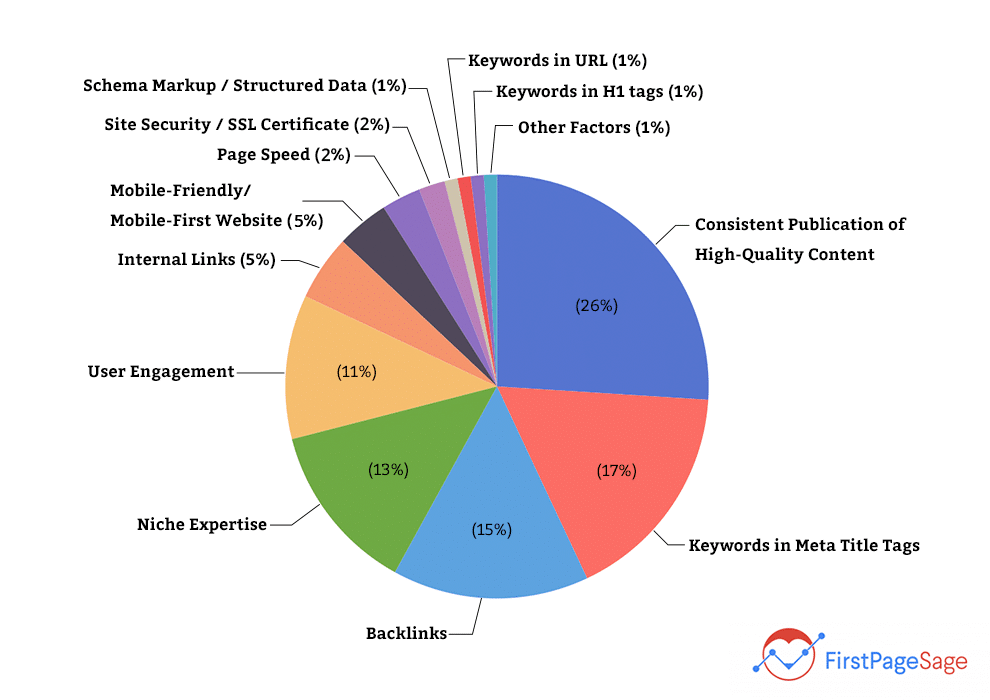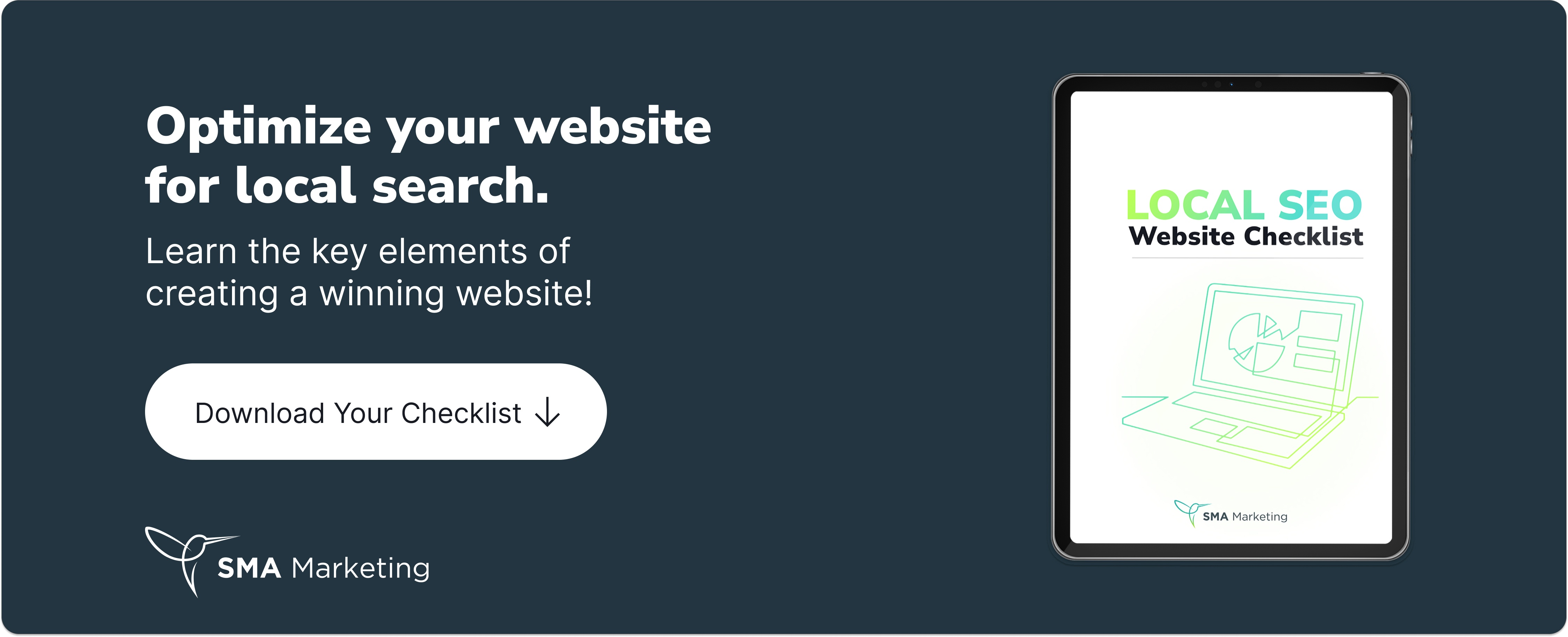Local SEO vs SEO: What’s the Difference?
 What is the difference between SEO and Local SEO? While they may share some tactics and best practices, getting your website to rank in local search takes a slightly different approach. In the video below, I’ll share the differences between SEO and Local SEO, explain why local SEO is important, as well as the main ranking factors that impact local search. If you are a local business owner trying to drive business to your website, this video is a must-watch.
What is the difference between SEO and Local SEO? While they may share some tactics and best practices, getting your website to rank in local search takes a slightly different approach. In the video below, I’ll share the differences between SEO and Local SEO, explain why local SEO is important, as well as the main ranking factors that impact local search. If you are a local business owner trying to drive business to your website, this video is a must-watch.
Video Transcript:
Why Local SEO Is Important
We’re going to talk about the difference between SEO and local SEO, and focus on the ranking factors for local search. We talk a lot about search engine optimization, inbound marketing, and digital marketing strategies, but not everything works the same across the board, and that goes for SEO strategies.
If you’re trying to rank a local business, like a local tire shop or a local pet store, you’re going to need to do things a little bit differently than if you’re trying to rank in the generic search.
When we talk about generic search or SEO, we typically talk about the blue links. Now, the SERPs (search engine ranking positions) are the list of the blue results. In the SERPs, we see some ads at the top. Sometimes we see a knowledge graph, and a “people also ask” question box also shows up. Sometimes we see a video.
When we’re talking about regular SEO, we’re talking about what’s showing up in the blue links, and we’re talking about usually ranking for broader terms that aren’t typically location-specific.
Local Search Is All About Location (Location, Location, Location)
It’s location-specific. We’re targeting people within a certain area that we want to drive to a local store or for a business that operates locally. Maybe you do a service like leak detection, and you show up at somebody’s house, but you’re still locally based.
When we talk about SEO, there are three core things that we know impact rank. We’ve talked about this in other blog posts.
1. Backlinks
Backlinks are links from one page to another. They can be internal or external. Internal backlinks come from pages that are linked to by the root domain name. External backlinks come from outside domains. Please check out this video about backlinks.
2. Content
The more unique, high-quality, authoritative, and engaging content you have, the better off you will be. Adding helpful content will help Google understand your site.
3. RankBrain
We’ve done some content on semantic search, using Hummingbird, and understanding the artificial intelligence that’s going behind how Google’s going to display the results. It’s about understanding the context of the situation to deliver the best answer with the shortest amount of clicks possible.
There’s a lot more that goes into it, but really we can think of RankBrain as the artificial intelligence machine learning aspect, where Google is looking at and analyzing the data, and then delivering the results based on what the computer deems most accurate.
Now, we also have these other little dots. Right? They’re pointing in. Well, these represent the hundreds of other ranking factors, schema markup, and structured data. We’re talking about on-page SEO. We’re talking about speed, a number of things that also impact how a site ranks in typical SEO. There’s a lot going on here, but when we pull up, this is kind of what we look at as the three main drivers for search.
Now, if we’re talking about local search, we’re talking about companies that are targeting somebody in a location, so this is when that box shows up. It’s the map, or we also call it the local pack. When you type in search queries like “dentist near me” or “dentist Melbourne Florida,” a map’s going to show up with a bunch of little red dots and certain dental offices are going to show up there. The map pack is going to show the following information:
- Their website.
- On a mobile device, it typically tells me how far away they are.
- A link to their website.
- A link to contact them or interact with them.
Top Local Pack Ranking Signals
The breakdown in the priority of ranking signals has shifted through the years. In 2022 after the Helpful Content Update, here’s a helpful chart from First Page Sage.
The local pack can be very powerful because it’s before the blue links. Before somebody sees a website listing, they’re going to see a Maps listing. Especially today with users being on mobile phones, when they see the local listing, they’re typically going to click that much quicker than scrolling down, especially if they need to visit a store.
There are a number of statistics that prove that before people visit a brick-and-mortar location, they will look it up online, and do some initial research, whether that be finding a number, finding a product, or finding a physical location.
The number one factor for your local website when it comes to ranking in the local pack is your My Business location. This is a Google entity, so you need to sign up for Google Business Profile.
You need to claim your business, which they’re going to need to mail you something. You can give a confirmation code. This is to keep your business location safe. It may seem like a nuisance, but it’s a really good thing. This way, nobody can just claim your business and claim to be you.
For this local business location, you can add your hours and phone number. You can add your description. You can add the categories you’re in. You can really optimize this to show people who you are. This listing is going to be powerful and it’s going to impact some of the other top eight ranking signals.
1. Optimize Your Google My Business Location
The number one thing you need to do is have your Google Business Profile optimized. Confirm your location and ensure it matches your brick-and-mortar or service areas. Then have your profile fully filled out. Make sure that you have it crystal clear, clean, and actionable, telling people about your business.
2. Links
The second factor is links. This is very similar to regular SEO. Links play a role because links show Google authority, and you don’t want links from just anywhere. You want them from quality sites. You want to make sure that you’re getting links from people that are contextually relevant to your industry.
3. On-page Signals
On-page signals go back to SEO best practices. To make sure that your site’s optimized for local search, make sure your NAP (Name, address, and phone number) is up to date. Those three core elements are essential to have on your site when you’re doing on-page optimization for a local business. People want to know where you are, who you are, and how to get in touch with you, and they want to be able to do it very quickly. Make sure you have your name, physical address, and phone number somewhere visible and easy to interact with. This is very important for local search.
4. Citations
The fourth is citations on sites like MapQuest, Yelp, Facebook, and Google Business Profile. These are other local listing sites. Your citation includes your name, address, phone number, and URL.
There are a lot of niche business directories for plumbers or daycare centers where you can also go and add your business, and you’re going to have these citations. These citations act like a link. When Google looks at your address and location, they’re going to search the web and look for citations that verify that information.
Now, here’s something that’s very critical that a lot of people miss. You want to ensure that the information on your citation matches your Google Business Profile. The name, phone number, address, and URL should be exactly the same.
This is going to be one of those pieces of information that Google will base information on, and if it’s different all over the web, it will be very confusing. They’re going to rank your site a lot lower. They’re going to rank your My Business profile a lot lower.
Make sure that when you’re filling out citations or you’re claiming citations you don’t have duplicates or random listings, and that all your information is synced together in one place. If you’re having trouble with that, send us a comment below. We can definitely help you get straightened out when it comes to citations.
5. Review Signals
The next piece of information is review signals. You need to have reviews. You need to have good customer reviews. You can send people to your Google Business Profile listing to add online reviews. Encourage your clients who have had a good experience to give you a review.
Now, here’s the sad part. People are way more likely to give you a negative online review than a positive review. Why is that? Well, if we have a bad experience, we’re typically angry about it, and what do we want to do? We want to tell people how angry we are. We’re going to find the listing and add a bad review.
If we have a good experience, we expect it to be a good customer experience. We say, “Hey, thanks. Yeah, you did your job. Why should I do anything else?” What we want to do is encourage people. Go above and beyond in service and then make it very easy for them to add a review to our site.
Whitespark.ca has a free tool that you can use where you find your location on Google, your My Business location, and it sets you up with a review link generator. It’s a free tool and very easy to use. It makes it a one-click step for your clients so that they can leave reviews.
You also want to get reviews on Yelp, Facebook, and other sites. Google can aggregate those and show them in your My Business listing, but predominantly these reviews will be on your Google Business Profile location.
6. Behavioral Signals
This is the number of people that click on your listing. How many people click on “Find more”? How many people click on your website? How many people click on your phone number? Google is tracking this information, and they’re going to use it when they’re ranking you.
If you aren’t getting a lot of clicks, you’re not getting a lot of action. They’re going to say, “Well, maybe people don’t like your business, so now we’re going to rank you lower.” This is why it’s so important to have your My Business location filled out completely to allow people to interact with you.
7. Personalization
This is something that’s completely out of your control. This is based on the user’s search history, location, and things of that nature. If they’re closer to your business, maybe you’ll show up a little bit higher. If they are further away. You may not show up for them at all.
This area doesn’t have a lot of play, but it’s still important, especially if you’re in a downtown location. If you optimize all these things we discussed above, you will have a much higher chance of getting found by those potential searchers.
I hope this gave you a better idea of the difference between searches. SEO is what we normally do from an organic ranking (non-location style), and local search is much more targeted at a local community, local businesses, and interactions with a community within a certain parameter.
When you want to show up online, when you want your local business to connect with people looking for you and your area, these eight practices are essential for you to get found.
Take the time to fill out your Google Business Profile. Do the research. Take control of all of these areas that you can control, and that you take the time and the effort to make sure that your citations are clean, that your listings are right, and that your Google Business Profile is completely filled out,
Then, interact with people. If they add a review, thank them for adding a review. If somebody didn’t have a good experience, try to make it right. Don’t argue with them, but try to admit your mistakes and empathize with them. Try to show people that you care.
It’s going to help build up your profile here, and it’s going to really help you show people that you’re human, that you want to do business with them. It’s also going to go show Google that you care, which can help you if you want to get a little bit higher in those ranking spots.
I hope you learned something today. Until next time, Happy Marketing.
Editor’s Note: This article was originally published on March 5, 2018, and has been updated with fresh content.









